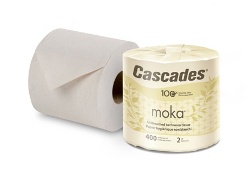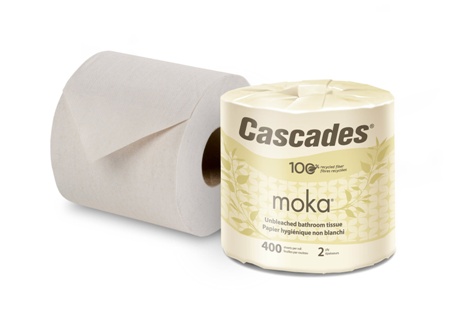
Is America Ready for Beige Unbleached Bathroom Tissue?

When Cascades Tissue Group, North America’s fourth largest producer of towel and tissue paper, unveiled their beige-colored Cascades Moka line of bathroom tissue at a recent tradeshow, distributers were initially concerned by the color.
"Then they would feel the product and say, 'Oh, wow, that is actually very soft!’” said Isabelle Faivre, the marketing director for Cascades Tissue Group. “And when they learned about our method for producing the 100-percent recycled, undyed and unbleached tissue, their interest immediately peaked.”
White toilet paper can be produced from recycled fiber without using chlorine—which is the main grievance against the bleaching process— but Cascades Tissue Group believes they have found an even more sustainable way of producing bath tissue by using a unique pulp recipe that is composed of 80-percent post-consumer paper materials and 20-percent recovered corrugated boxes. When the company performed a detailed life cycle analysis of Cascades Moka bathroom tissue and compared it to their 100-percent recycled bathroom tissue that undergoes a chlorine-free whitening process, it found that the environmental impact was lessened by at least 25 percent.
The United States uses 3.4 million tons of bath tissue annually. Despite having the capabilities to produce bath tissues made from recycled fiber, 54 percent of the tissue consumed continues to be produced using virgin fiber. Cascades estimates that if a complete swap was made to their environmentally preferable 100-percent recycled bath tissue, it would annually save 30.6 million trees and 68 million GJ of energy, which is enough to fuel the annual energy consumption of 619,811 households.
Since consumer tastes and habits often evolve in the public before their behaviors are modified at home, Cascades believes that the commercial market serves as the first frontier for sustainable innovations. Therefore, Cascades Moka is currently only available for the away-from-home market.
In recent years the napkin industry has seen a trend that Cascades thinks will be replicated by the bathroom tissue industry. Companies like Target and Cinnabon, for instance, have successfully waned off of white napkins and replaced them with recycled brown napkins. Many marketers believe that the beige napkins have actually become a badge of honor among businesses that wish to project a positive image to their environmentally-conscious customers.
“Beige is the new green, at least as it relates to towel and tissue,” said Suzanne Blanchet, CEO of Cascades Tissue Group, who personally conceived and championed Cascades Moka bath tissue’s development. “The last several years have brought about countless habit changes meant to preserve the environment. The quality of this bath tissue hasn’t been sacrificed one bit, so adjusting to a new color seems like a small step to take for even greater sustainability.”
But when it comes to bathroom tissue, will American consumers agree? Bath tissue distributed outside of the United States is offered in a variety of colors: apricot in the United Kingdom, green in Poland and orange in Switzerland. Americans, however, are more resistant to such changes.
Again, Cascades looks to the napkin industry as a predictor.
In the late ‘90s Cascades began its Moka concept with the introduction of the Moka napkin line. Commercial sales for the product have steadily increased year by year, as corporate purchasers and their employees and customers become more aware of its environmental benefits. In 2004 the Moka napkin line represented 10 percent of its total away-from-home sales in North America—now it represents more than 23 percent of case sales.
Cascades also believes that, aside from the environmental advantages of using recycled fiber in the production process, their business model will eventually lower the cost of the end product, which will be a savings that is passed on to the consumers.
Virgin pulp prices have more than doubled over the past three years, which has invoked price increases in recycled fiber as well. But by expanding and varying the types of fibers used in the production process, Cascades believes it can hedge its products’ exposure to commodity price fluctuations and white fiber shortages that rest outside of its control, thereby keeping tissue prices affordable in its served markets
Cascades Moka bathroom tissue is currently priced similarly to its white counterpart, with no discount or premium, but Cascades believes that will change as the trend catches on and more North American consumers see the immediate environmental benefits and eventual financial benefits of using recycled bath tissue.
“While the initial feedback for Cascades Moka has been extraordinarily positive,” Faivre said. “In the end, we will have to wait and see how American consumers react when they see our beige bathroom tissue in the stalls of their office, universities and hotels.”
So is America ready to sacrifice the white, virgin toilet paper its grown accustomed to if it means less of an environmental impact? When the benefits are rolled out onto the table, Cascades Tissue Group has faith that the answer will be “Yes.”
Ryan Benson works at Kohnstamm Communications, the agency of record for Cascades Tissue Group. O’Dwyer’s Public Relations News ranked Kohnstamm Communications 94th in its March 2010 annual ranking of independent public relations agencies. For more information, visit www.kohnstamm.com.
Posted on Feb 21, 2012